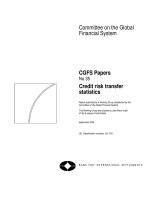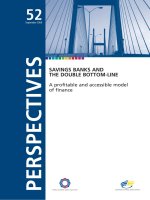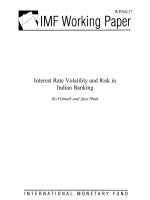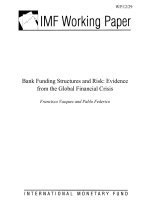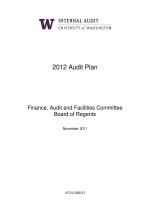Asset and Risk Management Risk Oriented Finance doc
Bạn đang xem bản rút gọn của tài liệu. Xem và tải ngay bản đầy đủ của tài liệu tại đây (4.73 MB, 416 trang )
Asset and Risk Management
Risk Oriented Finance
Louis Esch, Robert Kieffer and Thierry Lopez
C. Berb
´
e, P. Damel, M. Debay, J F. Hannosset
Asset and Risk Management
ebook3600.com
For other titles in the Wiley Finance Series
please see www.wiley.com/finance
Asset and Risk Management
Risk Oriented Finance
Louis Esch, Robert Kieffer and Thierry Lopez
C. Berb
´
e, P. Damel, M. Debay, J F. Hannosset
Published by John Wiley & Sons Ltd, The Atrium, Southern Gate, Chichester,
West Sussex PO19 8SQ, England
Telephone (+44) 1243 779777
Copyright
2005 De Boeck & Larcier s.a.
Editions De Boeck Universit
´
e
Rue des Minimes 39, B-1000 Brussels
First printed in French by De Boeck & Larcier s.a. – ISBN: 2-8041-3309-5
Email (for orders and customer service enquiries):
Visit our Home Page on www.wileyeurope.com or www.wiley.com
All Rights Reserved. No part of this publication may be reproduced, stored in a retrieval system or transmitted in
any form or by any means, electronic, mechanical, photocopying, recording, scanning or otherwise, except under the
terms of the Copyright, Designs and Patents Act 1988 or under the terms of a licence issued by the Copyright
Licensing Agency Ltd, 90 Tottenham Court Road, London W1T 4LP, UK, without the permission in writing of the
Publisher. Requests to the Publisher should be addressed to the Permissions Department, John Wiley & Sons Ltd,
The Atrium, Southern Gate, Chichester, West Sussex PO19 8SQ, England, or emailed to
,or
faxed to (+44) 1243 770620.
Designations used by companies to distinguish their products are often claimed as trademarks. All brand names and
product names used in this book are trade names, service marks, trademarks or registered trademarks of their
respective owners. The Publisher is not associated with any product or vendor mentioned in this book.
This publication is designed to provide accurate and authoritative information in regard to the subject matter
covered. It is sold on the understanding that the Publisher is not engaged in rendering professional services. If
professional advice or other expert assistance is required, the services of a competent professional should be sought.
Other Wiley Editorial Offices
John Wiley & Sons Inc., 111 River Street, Hoboken, NJ 07030, USA
Jossey-Bass, 989 Market Street, San Francisco, CA 94103-1741, USA
Wiley-VCH Verlag GmbH, Boschstr. 12, D-69469 Weinheim, Germany
John Wiley & Sons Australia Ltd, 33 Park Road, Milton, Queensland 4064, Australia
John Wiley & Sons (Asia) Pte Ltd, 2 Clementi Loop #02-01, Jin Xing Distripark, Singapore 129809
John Wiley & Sons Canada Ltd, 22 Worcester Road, Etobicoke, Ontario, Canada M9W 1L1
Wiley also publishes its books in a variety of electronic formats. Some content that appears
in print may not be available in electronic books.
Library of Congress Cataloging-in-Publication Data
Esch, Louis.
Asset and risk management : risk oriented finance / Louis Esch, Robert Kieffer, and Thierry
Lopez.
p. cm.
Includes bibliographical references and index.
ISBN 0-471-49144-6 (cloth : alk. paper)
1. Investment analysis. 2. Asset-liability management. 3. Risk management. I. Kieffer,
Robert. II. Lopez, Thierry. III. Title.
HG4529.E83 2005
332.63
2042—dc22
2004018708
British Library Cataloguing in Publication Data
A catalogue record for this book is available from the British Library
ISBN 0-471-49144-6
Typeset in 10/12pt Times by Laserwords Private Limited, Chennai, India
Printed and bound in Great Britain by Antony Rowe Ltd, Chippenham, Wiltshire
This book is printed on acid-free paper responsibly manufactured from sustainable forestry
in which at least two trees are planted for each one used for paper production.
Contents ix
11.4.1 Independent allocation 288
11.4.2 Joint allocation: ‘value’ and ‘growth’ example 289
11.5 Allocation of performance level 289
11.6 Gross performance level and risk withdrawal 290
11.7 Analysis of style 291
PART V FROM RISK MANAGEMENT TO ASSET AND LIABILITY
MANAGEMENT 293
Introduction 294
12 Techniques for Measuring Structural Risks in Balance Sheets 295
12.1 Tools for structural risk analysis in asset and liability management 295
12.1.1 Gap or liquidity risk 296
12.1.2 Rate mismatches 297
12.1.3 Net present value (NPV) of equity funds and sensitivity 298
12.1.4 Duration of equity funds 299
12.2 Simulations 300
12.3 Using VaR in ALM 301
12.4 Repricing schedules (modelling of contracts with floating rates) 301
12.4.1 The conventions method 301
12.4.2 The theoretical approach to the interest rate risk on floating
rate products, through the net current value 302
12.4.3 The behavioural study of rate revisions 303
12.5 Replicating portfolios 311
12.5.1 Presentation of replicating portfolios 312
12.5.2 Replicating portfolios constructed according to convention 313
12.5.3 The contract-by-contract replicating portfolio 314
12.5.4 Replicating portfolios with the optimal value method 316
APPENDICES 323
Appendix 1 Mathematical Concepts 325
1.1 Functions of one variable 325
1.1.1 Derivatives 325
1.1.2 Taylor’s formula 327
1.1.3 Geometric series 328
1.2 Functions of several variables 329
1.2.1 Partial derivatives 329
1.2.2 Taylor’s formula 331
1.3 Matrix calculus 332
1.3.1 Definitions 332
1.3.2 Quadratic forms 334
Appendix 2 Probabilistic Concepts 339
2.1 Random variables 339
2.1.1 Random variables and probability law 339
2.1.2 Typical values of random variables 343
Contents
Collaborators xiii
Foreword by Philippe Jorion xv
Acknowledgements xvii
Introduction xix
Areas covered xix
Who is this book for? xxi
PART I THE MASSIVE CHANGES IN THE WORLD OF FINANCE 1
Introduction 2
1 The Regulatory Context 3
1.1 Precautionary surveillance 3
1.2 The Basle Committee 3
1.2.1 General information 3
1.2.2 Basle II and the philosophy of operational risk 5
1.3 Accounting standards 9
1.3.1 Standard-setting organisations 9
1.3.2 The IASB 9
2 Changes in Financial Risk Management 11
2.1 Definitions 11
2.1.1 Typology of risks 11
2.1.2 Risk management methodology 19
2.2 Changes in financial risk management 21
2.2.1 Towards an integrated risk management 21
2.2.2 The ‘cost’ of risk management 25
2.3 A new risk-return world 26
2.3.1 Towards a minimisation of risk for an anticipated return 26
2.3.2 Theoretical formalisation 26
vi Contents
PART II EVALUATING FINANCIAL ASSETS 29
Introduction 30
3 Equities 35
3.1 The basics 35
3.1.1 Return and risk 35
3.1.2 Market efficiency 44
3.1.3 Equity valuation models 48
3.2 Portfolio diversification and management 51
3.2.1 Principles of diversification 51
3.2.2 Diversification and portfolio size 55
3.2.3 Markowitz model and critical line algorithm 56
3.2.4 Sharpe’s simple index model 69
3.2.5 Model with risk-free security 75
3.2.6 The Elton, Gruber and Padberg method of portfolio
management 79
3.2.7 Utility theory and optimal portfolio selection 85
3.2.8 The market model 91
3.3 Model of financial asset equilibrium and applications 93
3.3.1 Capital asset pricing model 93
3.3.2 Arbitrage pricing theory 97
3.3.3 Performance evaluation 99
3.3.4 Equity portfolio management strategies 103
3.4 Equity dynamic models 108
3.4.1 Deterministic models 108
3.4.2 Stochastic models 109
4 Bonds 115
4.1 Characteristics and valuation 115
4.1.1 Definitions 115
4.1.2 Return on bonds 116
4.1.3 Valuing a bond 119
4.2 Bonds and financial risk 119
4.2.1 Sources of risk 119
4.2.2 Duration 121
4.2.3 Convexity 127
4.3 Deterministic structure of interest rates 129
4.3.1 Yield curves 129
4.3.2 Static interest rate structure 130
4.3.3 Dynamic interest rate structure 132
4.3.4 Deterministic model and stochastic model 134
4.4 Bond portfolio management strategies 135
4.4.1 Passive strategy: immunisation 135
4.4.2 Active strategy 137
4.5 Stochastic bond dynamic models 138
4.5.1 Arbitrage models with one state variable 139
4.5.2 The Vasicek model 142
Contents vii
4.5.3 The Cox, Ingersoll and Ross model 145
4.5.4 Stochastic duration 147
5 Options 149
5.1 Definitions 149
5.1.1 Characteristics 149
5.1.2 Use 150
5.2 Value of an option 153
5.2.1 Intrinsic value and time value 153
5.2.2 Volatility 154
5.2.3 Sensitivity parameters 155
5.2.4 General properties 157
5.3 Valuation models 160
5.3.1 Binomial model for equity options 162
5.3.2 Black and Scholes model for equity options 168
5.3.3 Other models of valuation 174
5.4 Strategies on options 175
5.4.1 Simple strategies 175
5.4.2 More complex strategies 175
PART III GENERAL THEORY OF VaR 179
Introduction 180
6TheoryofVaR 181
6.1 The concept of ‘risk per share’ 181
6.1.1 Standard measurement of risk linked to financial products 181
6.1.2 Problems with these approaches to risk 181
6.1.3 Generalising the concept of ‘risk’ 184
6.2 VaR for a single asset 185
6.2.1 Value at Risk 185
6.2.2 Case of a normal distribution 188
6.3 VaR for a portfolio 190
6.3.1 General results 190
6.3.2 Components of the VaR of a portfolio 193
6.3.3 Incremental Va R 195
7 VaR Estimation Techniques 199
7.1 General questions in estimating VaR 199
7.1.1 The problem of estimation 199
7.1.2 Typology of estimation methods 200
7.2 Estimated variance–covariance matrix method 202
7.2.1 Identifying cash flows in financial assets 203
7.2.2 Mapping cashflows with standard maturity dates 205
7.2.3 Calculating VaR 209
7.3 Monte Carlo simulation 216
7.3.1 The Monte Carlo method and probability theory 216
7.3.2 Estimation method 218
viii Contents
7.4 Historical simulation 224
7.4.1 Basic methodology 224
7.4.2 The contribution of extreme value theory 230
7.5 Advantages and drawbacks 234
7.5.1 The theoretical viewpoint 235
7.5.2 The practical viewpoint 238
7.5.3 Synthesis 241
8 Setting Up a VaR Methodology 243
8.1 Putting together the database 243
8.1.1 Which data should be chosen? 243
8.1.2 The data in the example 244
8.2 Calculations 244
8.2.1 Treasury portfolio case 244
8.2.2 Bond portfolio case 250
8.3 The normality hypothesis 252
PART IV FROM RISK MANAGEMENT TO ASSET MANAGEMENT 255
Introduction 256
9 Portfolio Risk Management 257
9.1 General principles 257
9.2 Portfolio risk management method 257
9.2.1 Investment strategy 258
9.2.2 Risk framework 258
10 Optimising the Global Portfolio via VaR 265
10.1 Taking account of VaR in Sharpe’s simple index method 266
10.1.1 The problem of minimisation 266
10.1.2 Adapting the critical line algorithm to VaR 267
10.1.3 Comparison of the two methods 269
10.2 Taking account of VaR in the EGP method 269
10.2.1 Maximising the risk premium 269
10.2.2 Adapting the EGP method algorithm to VaR 270
10.2.3 Comparison of the two methods 271
10.2.4 Conclusion 272
10.3 Optimising a global portfolio via VaR 274
10.3.1 Generalisation of the asset model 275
10.3.2 Construction of an optimal global portfolio 277
10.3.3 Method of optimisation of global portfolio 278
11 Institutional Management: APT Applied to Investment Funds 285
11.1 Absolute global risk 285
11.2 Relative global risk/tracking error 285
11.3 Relative fund risk vs. benchmark abacus 287
11.4 Allocation of systematic risk 288
x Contents
2.2 Theoretical distributions 347
2.2.1 Normal distribution and associated ones 347
2.2.2 Other theoretical distributions 350
2.3 Stochastic processes 353
2.3.1 General considerations 353
2.3.2 Particular stochastic processes 354
2.3.3 Stochastic differential equations 356
Appendix 3 Statistical Concepts 359
3.1 Inferential statistics 359
3.1.1 Sampling 359
3.1.2 Two problems of inferential statistics 360
3.2 Regressions 362
3.2.1 Simple regression 362
3.2.2 Multiple regression 363
3.2.3 Nonlinear regression 364
Appendix 4 Extreme Value Theory 365
4.1 Exact result 365
4.2 Asymptotic results 365
4.2.1 Extreme value theorem 365
4.2.2 Attraction domains 366
4.2.3 Generalisation 367
Appendix 5 Canonical Correlations 369
5.1 Geometric presentation of the method 369
5.2 Search for canonical characters 369
Appendix 6 Algebraic Presentation of Logistic Regression 371
Appendix 7 Time Series Models: ARCH-GARCH and EGARCH 373
7.1 ARCH-GARCH models 373
7.2 EGARCH models 373
Appendix 8 Numerical Methods for Solving Nonlinear Equations 375
8.1 General principles for iterative methods 375
8.1.1 Convergence 375
8.1.2 Order of convergence 376
8.1.3 Stop criteria 376
8.2 Principal methods 377
8.2.1 First order methods 377
8.2.2 Newton–Raphson method 379
8.2.3 Bisection method 380
Contents xi
8.3 Nonlinear equation systems 380
8.3.1 General theory of n-dimensional iteration 381
8.3.2 Principal methods 381
Bibliography 383
Index 389
Collaborators
Christian Berb
´
e, Civil engineer from Universit
´
e libre de Bruxelles and ABAF financial
analyst. Previously a director at PricewaterhouseCoopers Consulting in Luxembourg, he
is a financial risk management specialist currently working as a wealth manager with
Bearbull (Degroof Group).
Pascal Damel, Doctor of management science from the University of Nancy, is conference
master for management science at the IUT of Metz, an independent risk management
consultant and ALM.
Michel Debay, Civil engineer and physicist of the University of Li
`
ege and master of
finance and insurance at the High Business School in Li
`
ege (HEC), currently heads the
Data Warehouse Unit at SA Kredietbank in Luxembourg.
Jean-Fran¸cois Hannosset, Actuary of the Catholic University of Louvain, currently man-
ages the insurance department at Banque Degroof Luxembourg SA, and is director of
courses at the Luxembourg Institute of Banking Training.
Foreword
by Philippe Jorion
Risk management has truly undergone a revolution in the last decade. It was just over 10
years ago, in July 1993, that the Group of 30 (G-30) officially promulgated best practices
for the management of derivatives.
1
Even though the G-30 issued its report in response
to the string of derivatives disasters of the early 1990s, these best practices apply to all
financial instruments, not only derivatives.
This was the first time the term ‘Value-at-Risk’ (Va R ) was publicly and widely men-
tioned. By now, VaR has become the standard benchmark for measuring financial risk.
All major banks dutifully report their VaR in quarterly or annual financial reports.
Modern risk measurement methods are not new, however. They go back to the concept
of portfolio risk developed by Harry Markowitz in 1952. Markowitz noted that investors
should be interested in total portfolio risk and that ‘diversification is both observed and
sensible’. He provided tools for portfolio selection. The new aspect of the VaR revolution
is the application of consistent methods to measure market risk across the whole institution
or portfolio, across products and business lines. These methods are now being extended
to credit risk, operational risk, and to the final frontier of enterprise-wide risk.
Still, risk measurement is too often limited to a passive approach, which is to measure or
to control. Modern risk-measurement techniques are much more useful than that. They can
be used to manage the portfolio. Consider a portfolio manager with a myriad of securities
to select from. The manager should have strong opinions on most securities. Opinions,
or expected returns on individual securities, aggregate linearly into the portfolio expected
return. So, assessing the effect of adding or subtracting securities on the portfolio expected
return is intuitive. Risk, however, does not aggregate in a linear fashion. It depends on the
number of securities, on individual volatilities and on all correlations. Risk-measurement
methods provide tools such as marginal Va R , component VaR , and incremental Va R ,that
help the portfolio manager to decide on the best trade-off between risk and return. Take
a situation where a manager considers adding two securities to the portfolio. Both have
the same expected return. The first, however, has negative marginal Va R ; the second has
positive marginal VaR . In other words, the addition of the first security will reduce the
1
The G-30 is a private, nonprofit association, founded in 1978 and consisting of senior representatives of the private and
public sectors and academia. Its main purpose is to affect the policy debate on international economic and financial issues.
The G-30 regularly publishes papers. See www.group30.org.
xvi Foreword
portfolio risk; the second will increase the portfolio risk. Clearly, adding the first security
is the better choice. It will increase the portfolio expected return and decrease its risk.
Without these tools, it is hard to imagine how to manage the portfolio. As an aside, it is
often easier to convince top management of investing in risk-measurement systems when
it can be demonstrated they can add value through better portfolio management.
Similar choices appear at the level of the entire institution. How does a bank decide
on its capital structure, that is, on the amount of equity it should hold to support its
activities? Too much equity will reduce its return on equity. Too little equity will increase
the likelihood of bankruptcy. The answer lies in risk-measurement methods: The amount
of equity should provide a buffer adequate against all enterprise-wide risks at a high
confidence level. Once risks are measured, they can be decomposed and weighted against
their expected profits. Risks that do not generate high enough payoffs can be sold off or
hedged. In the past, such trade-offs were evaluated in an ad-hoc fashion.
This book provides tools for going from risk measurement to portfolio or asset man-
agement. I applaud the authors for showing how to integrate Va R -based measures in the
portfolio optimisation process, in the spirit of Markowitz’s portfolio selection problem.
Once risks are measured, they can be managed better.
Philippe Jorion
University of California at Irvine
Acknowledgements
We want to acknowledge the help received in the writing of this book. In particular, we
would like to thank Michael May, managing director, Bank of Bermuda Luxembourg S.A.
and Christel Glaude, Group Risk Management at KBL Group European Private Bankers.
Part I
The Massive Changes in the World
of Finance
Introduction
1 The Regulatory Context
2 Changes in Financial Risk Management
2 Asset and Risk Management
Introduction
The financial world of today has three main aspects:
• An insurance market that is tense, mainly because of the events of 11 September 2001
and the claims that followed them.
• Pressure of regulations, which are compelling the banks to quantify and reduce the
risks hitherto not considered particular to banks (that is, operational risks).
• A prolonged financial crisis together with a crisis of confidence, which is pressurising
the financial institutions to manage their costs ever more carefully.
Against this background, the risk management function is becoming more and more
important in the finance sector as a whole, increasing the scope of its skills and giving
the decision-makers a contribution that is mostly strategic in nature. The most notable
result of this is that the perception of cost is currently geared towards the creation of
value, while as recently as five years ago, shareholders’ perceptions were too heavily
weighted in the direction of the ‘cost of doing business’.
It is these subjects that we propose to develop in the first two chapters.
1
The Regulatory Context
1.1 PRECAUTIONARY SURVEILLANCE
One of the aims of precautionary surveillance is to increase the quality of risk management
in financial institutions. Generally speaking:
• Institutions whose market activity is significant in terms of contribution to results or
expenditure of equity fund cover need to set up a risk management function that is
independent of the ‘front office’ and ‘back office’ functions.
• When the establishment in question is a consolidating business, it must be a decision-
making centre. The risk management function will then be responsible for suggesting a
group-wide policy for the monitoring of risks. The management committee then takes
the risk management policy decisions for the group as a whole.
• To do this, the establishment must have adequate financial and infrastructural resources
for managing the risk. The risk management function must have systems for assessing
positions and measuring risks, as well as adequate limit systems and human resources.
The aim of precautionary surveillance is to:
• Promote a well-thought-out and prudent business policy.
• Protect the financial stability of the businesses overseen and of the financial sector as
a whole.
• Ensure that the organisation and the internal control systems are of suitable quality.
• Strengthen the quality of risk management.
1.2 THE BASLE COMMITTEE
We do not propose to enter into methodological details on the adequacy
1
of equity capital
in relation to credit, market and operational risks.
On the other hand, we intend to spend some time examining the underlying philosophy
of the work of the Basle Committee
2
on banking controls, paying particular attention to
the qualitative dynamic (see 1.2.2 below) on the matter of operational risks.
1.2.1 General information
The Basle Committee on Banking Supervision is a committee of banking supervisory authorities,
which was established by the central bank governors of the Group of Ten countries in 1975. It
consists of senior representatives of bank supervisory authorities and central banks from Belgium,
1
Interested readers should read P. Jorion, Financial Risk Manager Handbook (Second Edition), John Wiley & Sons, Inc.
2003, and in particular its section on regulation and compliance.
2
Interested readers should consult />4 Asset and Risk Management
Canada, France, Germany, Italy, Japan, Luxembourg, the Netherlands, Sweden, Switzerland, the
United Kingdom and the United States. It usually meets at the Bank for International Settlements
in Basle, where its permanent Secretariat is located.
3
1.2.1.1 The current situation
The aim of the capital adequacy ratio is to ensure that the establishment has sufficient
equity capital in relation to credit and market risks. The ratio compares the eligible equity
capital with overall equity capital requirements (on a consolidated basis where necessary)
and must total or exceed 100 % (or 8 % if the denominator is multiplied by 12.5). Two
methods, one standard and the other based on the internal models, allow the requirements
in question to be calculated.
In addition, the aim of overseeing and supervising major risks is to ensure that the
credit risk is suitably diversified within the banking portfolios (on a consolidated basis
where necessary).
1.2.1.2 The point of the ‘New Accord’
4
The Basle Committee on Banking Supervision has decided to undertake a second round of
consultation on more detailed capital adequacy framework proposals that, once finalised, will
replace the 1988 Accord, as amended.
The new framework is intended to align capital adequacy assessment more closely with the key
elements of banking risks and to provide incentives for banks to enhance their risk measurement
and management capabilities.
The Committee’s ongoing work has affirmed the importance of the three pillars of the
new framework:
1. Minimum capital requirements.
2. Supervisory review process.
3. Market discipline.
A. First aspect: minimum capital requirements
The primary changes to the minimum capital requirements set out in the 1988 Accord are in
the approach to credit risk and in the inclusion of explicit capital requirements for operational
risk. A range of risk-sensitive options for addressing both types of risk is elaborated. For credit
risk, this range begins with the standardised approach and extends to the “foundation” and
“advanced” internal ratings-based (IRB) approaches. A similar structure is envisaged for opera-
tional risk. These evolutionary approaches will motivate banks to continuously improve their risk
management and measurement capabilities so as to avail themselves of the more risk-sensitive
methodologies and thus more accurate capital requirements.
B. Second aspect: supervisory review process
The Committee has decided to treat interest rate risk in the banking book under Pillar 2 (super-
visory review process). Given the variety of underlying assumptions needed, the Committee
3
The Bank for International Settlements, Basle Committee on Banking Supervision, Vue d’ensemble du Nouvel accord de
Bˆale sur les fonds propres, Basle, January 2001, p. 1.
4
Interested readers should also consult: The Bank for International Settlements, Basle Committee on Banking Control, The
New Basle Capital Accord, January 2001; and The Bank for International Settlements, Basle Committee on Banking Control,
The New Basle Capital Accord: An Explanatory Note, January 2001.
The Regulatory Context 5
believes that a better and more risk-sensitive treatment can be achieved through the supervisory
review process rather than through minimum capital requirements. Under the second pillar of the
New Accord, supervisors should ensure that each bank has sound internal processes in place to
assess the adequacy of its capital based on a thorough evaluation of its risks. The new framework
stresses the importance of bank’s management developing an internal capital assessment process
and setting targets for capital that are commensurate with the bank’s particular risk profile and
control environment.
C. Third aspect: Market discipline
The Committee regards the bolstering of market discipline through enhanced disclosure as a
fundamental part of the New Accord.
5
The Committee believes the disclosure requirements
and recommendations set out in the second consultative package will allow market partici-
pants to assess key pieces of information on the scope of application of the revised Accord,
capital, risk exposures, assessment and management processes, and capital adequacy of banks.
The risk-sensitive approaches developed by the Committee rely extensively on banks’ internal
methodologies giving banks more discretion in calculating their capital requirements. Separate
disclosure requirements are put forth as prerequisites for supervisory recognition of internal
methodologies for credit risk, credit risk mitigation techniques and asset securitisation. In the
future, disclosure prerequisites will also attach to advanced approaches to operational risk. In
the view of the Committee, effective disclosure is essential to ensure that market participants
can better understand banks’ risk profiles and the adequacy of their capital positions.
1.2.2 Basle II and the philosophy of operational risk
6
In February 2003, the Basle Committee published a new version of the document Sound
Practices for the Management and Supervision of Operational Risk. It contains a set of
principles that make up a structure for managing and supervising operational risks for
banks and their regulators.
In fact, risks other than the credit and market risks can become more substantial as
the deregulation and globalisation of financial services and the increased sophistication
of financial technology increase the complexity of the banks’ activities and therefore that
of their risk profile.
By way of example, the following can be cited:
• The increased use of automated technology, which if not suitably controlled, can trans-
form the risk of an error during manual data capture into a system breakdown risk.
• The effects of e-business.
• The effects of mergers and acquisitions on system integration.
• The emergence of banks that offer large-scale services and the technical nature of the
high-performance back-up mechanisms to be put in place.
5
See also Point 1.3, which deals with accounting standards.
6
This section is essentially a summary of the following publication: The Bank for International Settlements, Basle Com-
mittee on Banking Control, Sound Practices for the Management and Supervision of Operational Risk, Basle, February 2003. In
addition, interested readers can also consult: Cruz M. G., Modelling, Measuring and Hedging Operational Risk, John Wiley &
Sons, Ltd, 2003; Hoffman D. G., Managing Operational Risk: 20 Firm-Wide Best Practice Strategies, John Wiley & Sons, Inc.,
2002; and Marshall C., Measuring and Managing Operational Risks in Financial Institutions, John Wiley & Sons, Inc., 2001.


